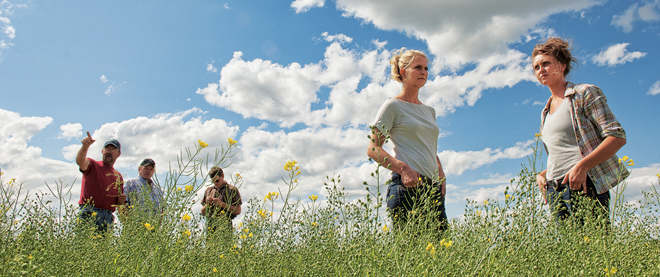From ancient grains, a healthy new oil
Buyers can even track each bottle to the particular Saskatchewan farm it came from
Photographs by Nayan Sthankiya
Share

It’s a long way from Midale, Sask., to Pusateri’s Fine Foods in north Toronto. Some 2,500 km—and a seismic attitudinal shift—separate the rural farming town (pop. 500) from the urban emporium that sells $40 olive oils and $8 quarts of strawberries. Bridging that gap is what brought sisters Elysia and Natasha Vandenhurk to Toronto last month in their first promotional push for Three Farmers’ oil, made from camelina sativa, an ancient grain formerly used only in North America to make biodiesel fuel.
That was before three lifelong Saskatchewan farmers—Colin Rosengren, Ron Emde and Natasha’s and Elysia’s father, Dan Vandenhurk, along with soil scientist Ken Greer—embarked on their bold culinary-alchemy experiment: cold-pressing the grain into an “artisanal” oil targeted at food- and nutrition-conscious consumers who want to know where their food comes from and are willing to pay $24.99 a 500-ml bottle for the privilege.
That quest has brought the 24-year-old Elysia, a trained chef, to Pusateri’s where, on a June weekend, she has set up a tasting station with the pure oil (which has a pleasant, nutty flavour), a herb-infused version and hummus, accompanied by bread for dipping. As curious shoppers hover, she enumerates the various marvels of the oil, which is used in Europe: it’s rich in omega-3 and omega-6 as well as vitamin E, which gives it shelf stability for 12 months. “It’s fantastic for roasting asparagus and drizzling on mashed potatoes,” she says, with a high smoke point of 475° F that makes it good for sautéing.
Meanwhile, across town, Natasha, 26, is delivering a similar spiel at the similarly upscale Cheese Boutique. “We want a clientele who care about what they are consuming,” she says. They’re selling only to specialty stores, not supermarkets—“the land of genetically modified canola,” as Natasha calls them—which charge big shelving fees (it’s also available online).
The seed of the idea to harvest camelina sativa came to Rosengren four years ago at a Montana State University meeting that focused on the grain’s use as a biofuel. “They said it wasn’t a good high-quality food crop,” he says. “But it is; it just wasn’t registered as one.” Corporations had overlooked the non-genetically modified grain, which is cheap and easy to grow without herbicides or pesticides. “They focus on large-market, large-volume things like canola,” he says. “And camelina isn’t about to replace it.” Seeing potential in the grain’s fatty-acid profile, they researched possible uses, such as omega-3 supplements, skin care and an edible oil. Producing a finished product was important, says Natasha: “In Saskatchewan we have a history of shipping our products out as commodities and buying them back way more expensively as finished goods. So why not create jobs and ship it out as a finished good?”
Health Canada issued its approval last November, and the first 4,000 bottles were produced in March. The brand has been cultivated to emphasize its agrarian roots and farm-to-table sensibility; there’s even a tracking number on each bottle to trace the oil’s harvest path on ThreeFarmers.com.
The focus now is on education and distribution, with Elysia working on possible line extensions, such as packaged hummus. It’s been a steep learning curve, says Natasha, referring to a “hummus disaster” that cost them thousands of dollars. Even figuring out pricing was a challenge: “I asked one shop owner if selling it retail for $15 would be too much. He said ‘Are you kidding? You should retail at $20.’ ” Reception has been enthusiastic. Jane Rodmell, the owner of All the Best food shop in Toronto, loves the product, citing its flavour, versatility and healthfulness.
Still, marketing on a shoestring is a challenge. Even though “a lot of people told us you’re doing something that’s nearly impossible unless you have unlimited funds,” they remain upbeat. “We’re not making money yet but every person we talk to helps.” Hence the 23-hour car trips across the country. “No one can tell your story like you can tell your story,” says Natasha. That’s true—at least until their story becomes the stuff of Canadian food lore.